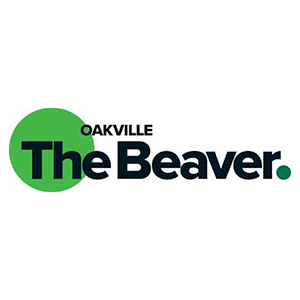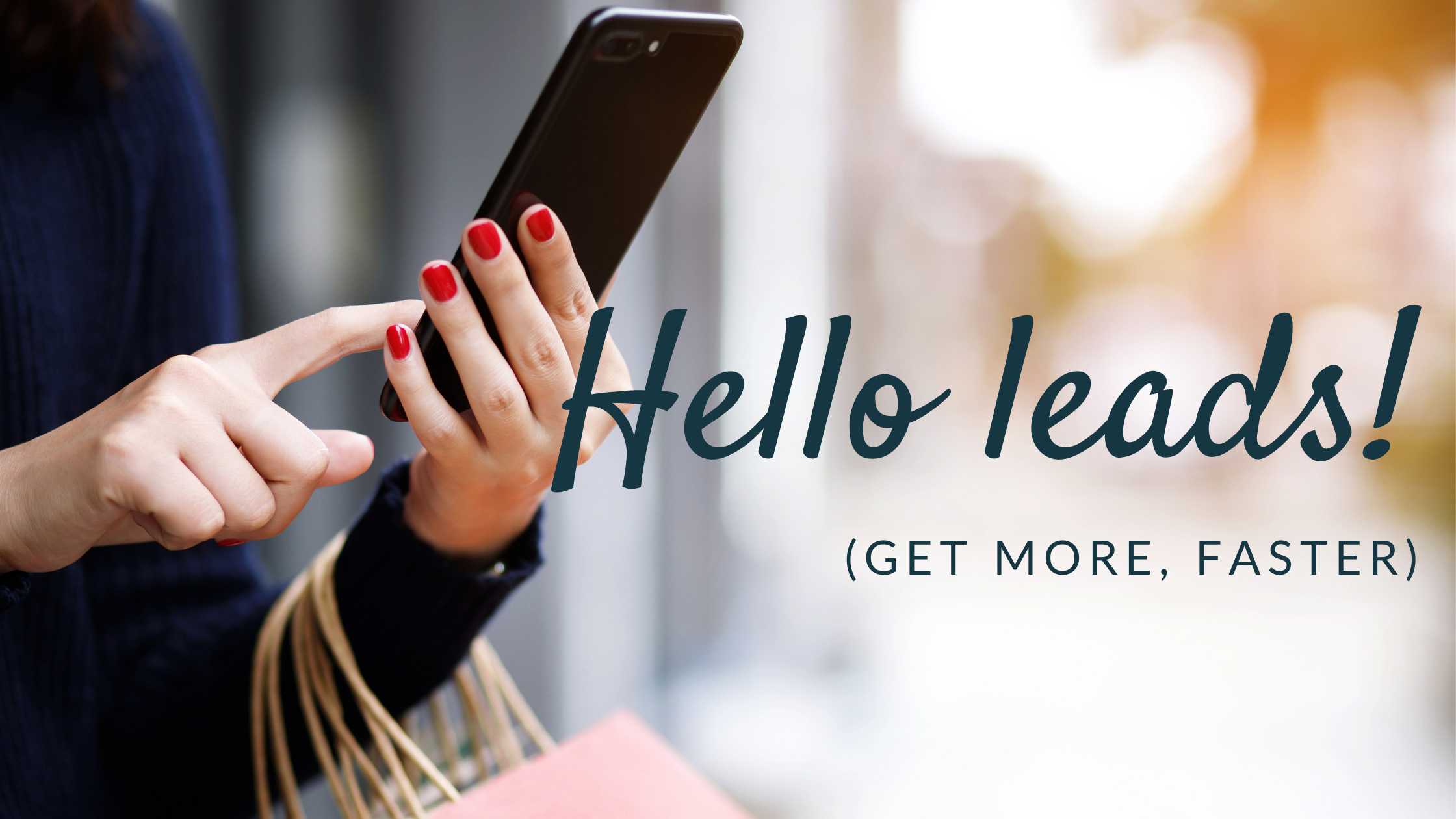
How do you create high-converting lead magnets?
In other words, how do you get more people to hand over their email addresses and consent to receive emails in exchange for whatever incentive you’re offering?
Well, it’s like any other conversion. You get more people to say “yes” to your lead magnet by better understanding what they want.
I’ll explain. But before we dive deeper…
What Businesses Should Be Creating Lead Magnets & Why?
In some industries, creating lead magnets and optimizing them to convert is a fine art.
If you’re trolling the sites of marketers, course creators, coaches, you’ll find stellar examples. The lead magnet sophistication in those markets is high!
But businesses outside of these sectors often leave money on the table because they don’t have high-converting lead magnets.
Maybe you’ve been defaulting to a “sign up for tips and tricks” CTA in the footer of your site. Only, no one is signing up.
Or, like most e-commerce brands, you’re offering a 10% discount in exchange for an email. You know that discount incentives are a conversion killer, long-term, but you’re not sure what else to offer…
Instead, why not create a lead magnet that increases the perceived value of what you’re offering, so discounts become less necessary?
Ready?
In this post, I’ll share examples of high-converting lead magnets from my own business.
The steps and principles are for any business that needs to build a list, faster, with subscribers who are more likely to buy.
Terms Commonly Used When We Talk About Lead Magnets
As I wrote this I found myself constantly wanting to define terms. So, let’s just get that out of the way:
- Lead magnet: Any freebie given in exchange for an email address and consent to receive marketing emails
- Opt-in: Depends on the context. Opt-in can refer to the lead magnet itself, as in the opt-in incentive. Often, it refers to the form via which a subscriber signs up. Sometimes marketers say “get the opt-in” when referring to a conversion.
- Opt-in form: Usually a box where a visitor can opt into the lead magnet
- Squeeze page: A page designed to persuade a visitor to say “yes” to the lead magnet
- Conversion rate: How many people say “yes” out of the total number of people who see your lead magnet or paid offer
- Gated/ungated content: Ungated content can be viewed by anyone, without subscribing. Gated content is only available to subscribers, or sometimes, members/buyers.
Terms I missed? Let me know in the comments.
Moving on.
What is a Good Conversion Rate for a Lead Magnet?
It depends on the industry, but let’s keep this simple.
Here’s how to define a “good conversion rate” according to Leadpages:
“Broadly speaking, a common conversion rate for an email opt-in landing page is between 5% and 15%.
The companies with the most success tend to convert at around 20-25%.
And the very cream of the crop achieves conversion rates of 30% or higher.”
My lead magnet conversion rates have hovered around 50% to 60%.
That means I’m able to turn more visitors into email subscribers than the average business.
And yet, having a high-converting lead magnet isn’t enough… As we’ll discuss.
About that Email List Size…

In another post, I’ve shared the stats from my broadcast emails, including open rates, click-through rates, and unsubscribes.
As you scroll through those broadcast emails, you’ll notice a tiny number (my subscriber list) get gradually bigger.
Prioritizing Lead Quality Over Quantity: One Lead Gen Strategy
I have very few lead magnets that I use to slowly, passively, organically generate business.
People find us through search and opt-in to the list at the rate of about one a day. (Search volume for my niche is very low.)
Until 2022, I had no pop-ups or sliders.
The opt-ins that have grown my list over the years are located in places where only very interested leads will find them. (Leads who convert to clients more often.)
When someone subscribes, they get a series of emails relevant to that opt-in.
I use those email sequences to link to related content and services. All of this is easily set up in ConvertKit (that’s an affiliate link, btw).
And that’s it.
For a business like Conversion Copy Co, I don’t need to do more.
Lead quality is more important for my business than lead quantity.
But you may have a more scalable business, like a product-based business, and need to grow your list rapidly.
Driving Maximum Traffic to Your Lead Magnet for Rapid List Growth
If you sell products or have a scalable business model, go ahead and supercharge your list growth with strategies to drive more traffic and get more eyes on your lead magnets.
Rapid list growth strategies include:
- Driving paid traffic to pages optimized to convert
- Testing different types of pop-ups
- Guest posting with permission to include a link to your opt-in
- Guest appearing on webinars or podcasts and sharing a link to your opt-in
- Adding content upgrades EVERYWHERE
Of course, even if faster list growth = more profit for your business, pay attention to lead quality.
Choose strategies that attract buyers, not just emails. That’s how you get the best ROI on email marketing.
Fast-Growth List Building Strategies & Lead Magnets to Avoid
Obviously, don’t buy emails!
But also, avoid contests, product giveaways, and in most cases, free samples of physical products in exchange for an email.
These list growth methods attract freebie hunters who aren’t likely to buy. Freebie hunters just sit on your list driving down conversion rates while costing you subscription fees.
Sampling is more effective when:
a) you’ve already qualified the lead, and
b) trying your product effectively sells your product.
No really. Does the sample sell your product?
I’m thinking of a time I signed up for free samples of a new skincare brand. It was a very generous gift (about a two-week supply of several products).
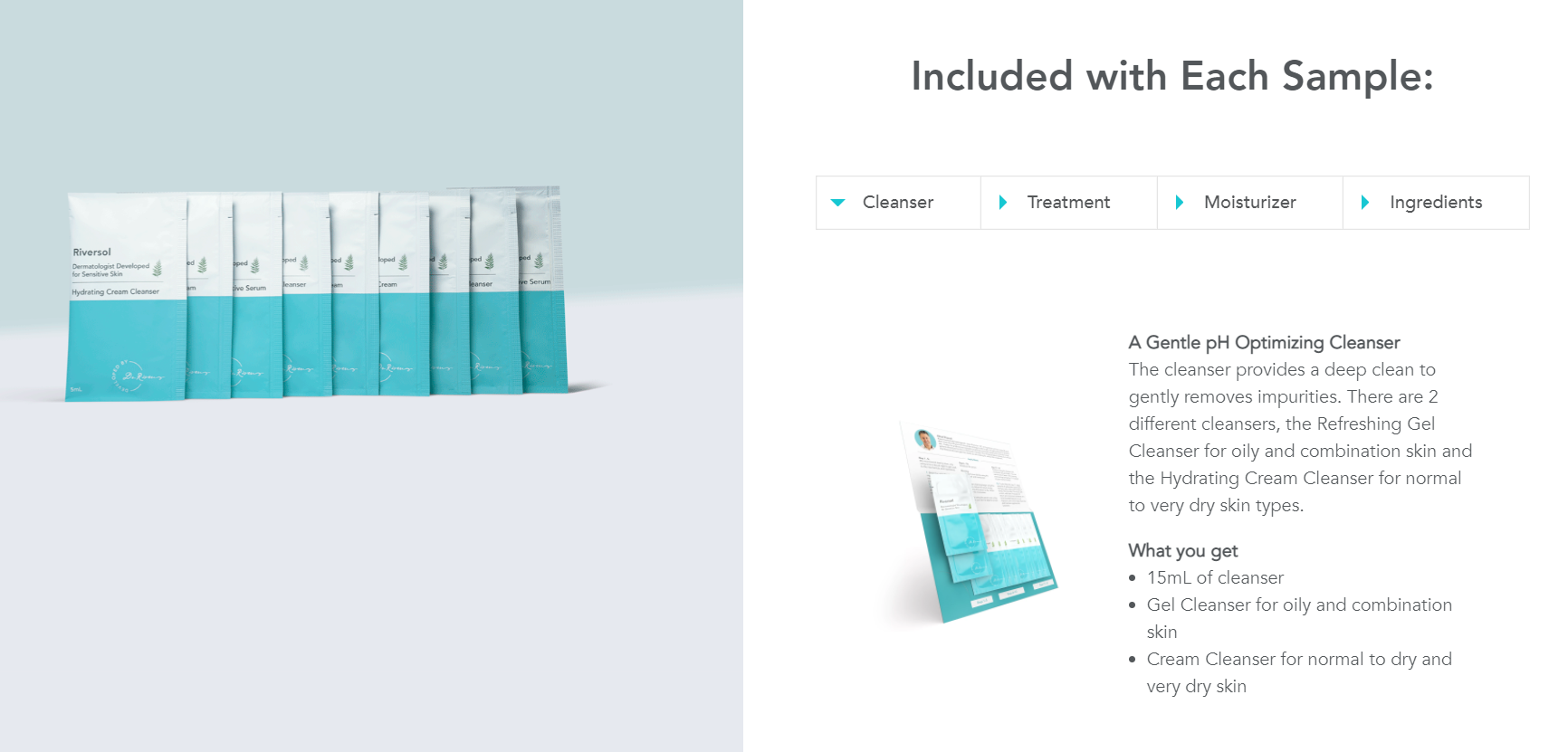
As I used the samples, I realized that I couldn’t tell whether the products are better than those I already use, from another brand.
(And switching skincare is risky. It’s like Dorian Gray stabbing his own portrait. You don’t mess with a good thing.)
Yes, the brand sent me educational emails, but I wasn’t motivated enough to read them. (I’m sorry!)
Instead, Riversol could have hooked me with doubt about my existing skincare brand and followed up with emails that persuade me to switch.
Or, they could have qualified and segmented leads based on whether they use another skincare brand.
Takeaway: A trial might convert a lead who doesn’t yet have a good solution. It’s not always enough to make leads switch brands.
Avoiding Lead Magnet Conversion Killers

Whether you get a ton of traffic to your opt-in or a tiny stream…
A higher conversion rate builds your list faster. If your visitor-to-subscriber conversion rate is low, it could be due to any of these:
- Confusion: The copy isn’t clear. People don’t know what they’ll get or why.
- Disinterest: Maybe it’s clear, but it’s not a desirable freebie. Possibly the lead magnet title (or even the topic) just isn’t juicy enough
- Mistrust: Dodgy design or UX around the opt-in form is scaring people off.
These are all fixable, and this post will help you understand how to increase clarity and interest, so your lead magnet is more desirable.
Related Issue: Low Conversion Rate to Sale
Now, sometimes your squeeze page or opt-in form is converting just fine, but your conversion rate to sale is low.
That means, people are saying “yes” to your free lead magnet but once they’re on your list, they’re not saying “yes” to your paid offers. In that case, one of the following may be the issue:
- Your lead magnet is attracting people who will never buy
- The content doesn’t get people excited about your brand and your offers
- You’re giving away TOO much for free (so people don’t need to buy)
- Your lead magnet content doesn’t “fit” with what you sell
- Your intro offer isn’t well-priced or attractive, so subscribers don’t take the next step
- Your emails need to be optimized for conversion… A whole other topic!
Filter your ideas through this list as you come up with your lead magnet strategy. If you do, you’ll create a lead magnet that’s not only optimized to grow your list but to grow your business.
12 Steps to a Lead Magnet that Converts + Template

High-converting copy is based on knowing your prospect really, very well.
The same goes with high-converting lead magnets.
That’s why we ideate not by thinking, “Hmmm, what am I very knowledgeable about?” Or, “Hmmm, what do I have kicking around that I can repurpose?”
Nope. We start with the most painful problems. Specifically, the problems your leads are aware that they have.
As business mentor and former conversion copywriter Merel Kriegsman says:
“You want to offer something tied to a problem your leads are already conscious they have, versus a lead magnet targeting those who are unaware that they’re struggling.
When you look at the journey of awareness, aim to create a lead magnet that sits really close to the solution-aware stage.
Because you want to capture the leads that are perfectly poised to have a transformation. Not the people who are just realizing they have a problem.“
How do we do that? Again, turning to your customer research…
- List the most painful problems your ideal buyers experience
- Choose a problem that’s common and hard to solve for those ideal buyers
- Make sure it’s a problem solved by one of your products or services
- Come up with a list of what your lead needs to feel to become a buyer
- List what your lead needs to believe to become a buyer
- List what your lead needs to know to become a buyer
- List what your lead needs to have in place to become a buyer
- Set aside ideas that are better off ungated or as buyer bonuses (more on this below)
- Choose one of the above (feel, know, believe, or have in place) and create content that equips the reader to become a better buyer
- Build in a CTA linked to the next offer in your ladder
- Weave in messaging about why you + plenty of proofs (social, awards, certifications)
- Name it to pique curiosity and desire
You can use my simple ideation template. (Just make a copy to your own Google Drive.)
Here’s a little video on how I use the template:
Of course, your next steps are to design your lead magnet, create the landing page or opt-in form, write and connect the email autoresponders…
But getting the topic right is the most important part.
You’ll notice the emphasis on what your lead needs to become a buyer.
This is the special twist.
This is the strategy that separates “great-in-theory” lead magnets from lead magnets that drive a ton of demand for your business.
I used this strategy intuitively with my second (most profitable) lead magnet. Later, when I studied buyer enablement, I realized why it works so well:
Lead magnets like this remove the last barriers to buying.
How to Generate a Hot Lead Magnet (Example)

Say you own an alternative medicine apothecary, with virtual consulting. Your ideal customers are busy executives and professionals. Again, based on voice-of-customer research, you know them well.
Let’s walk through the 12 steps in this example:
- Painful problems: insomnia, weight gain, fatigue, low libido, moodiness
- You choose fatigue as the most common issue, at the root of the rest
- You sell a protocol that helps them to normalize the functioning of their adrenal glands, so they don’t experience the crash and burn symptoms of constant stress
- What they need to feel: that their fatigue is solvable, without a total life overhaul
- What they need to believe: that alternative medicine with personal consulting can make a huge difference
- What they need to know: what types of alternative medicine are best for their fatigue
- What they need to have in place: a list of medications to check for contraindications
- You set aside some ideas for ungated content and a buyer bonus (more below)
- You decide to create a lead magnet (a guide or a quiz) that helps leads identify their stress style + recommends a personalized “calm energy protocol”
- You build in a CTA to sign-up for a free 15-minute alternative medicine consultation
- You insert your proofs, including testimonials from customers who have gone from burnout to bliss
- You use language like “What your stress style says about how you can fight fatigue”
Repeat this process endlessly to generate as many high-converting lead magnets as you like.
Mistakes You Can Still Make Even If You Follow These Exact Steps
After brainstorming, switch hats and get critical.
Put yourself in the shoes of a skeptical, distractable, whimsical lead.
Ask whether the lead magnet idea will really bring that lead closer to the next most valuable conversion.
Because even if you’ve followed the above steps, you can still waste time and energy on a lead magnet that doesn’t grow your business.
Here are two risks we haven’t yet talked about.
Risk: Instead of lifting your brand, your lead magnet lifts demand for your category in general.
Returning to the example above, that apothecary could make the mistake of focusing the guide or quiz on the category of products they sell, versus the unique value they add.
To avoid this, weave your unique value prop throughout the lead magnet content, so the natural next step is to choose you and only you.
Risk: Your lead magnet serves your ideal buyer but distracts from the sale.
Returning to our example, it’s quite likely that your lead needs to make changes to their diet and lifestyle to get the best results from the natural medicine that you sell.
But would a how-to guide on that topic increase your lead’s desire for your products? Or will it send them running off in other directions?
Make sure the content naturally generates demand for what you sell.
Ungated Content, Lead Magnet, or Free Bonus?
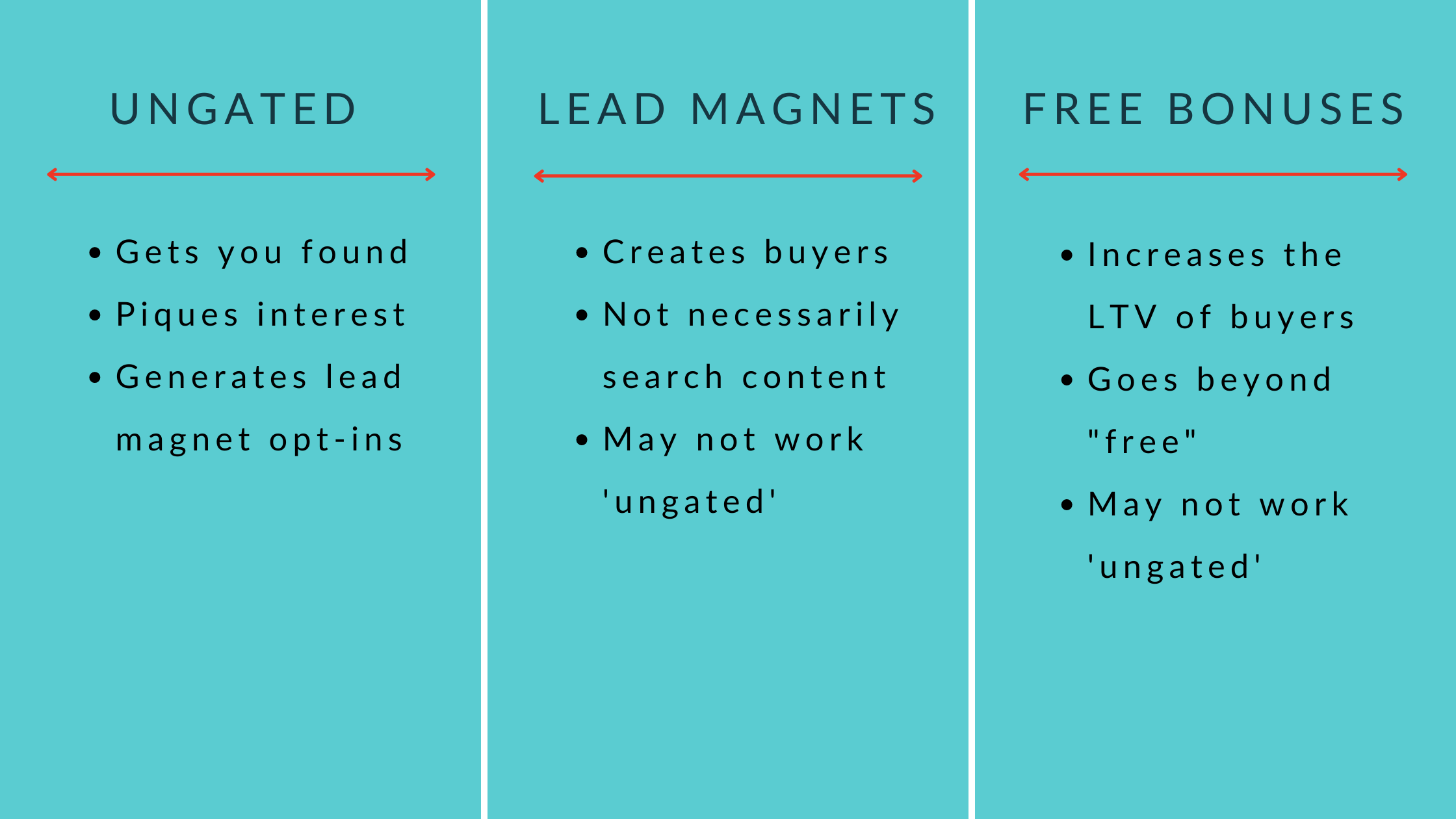
Just to quickly expand on the above…
When you follow the 12 steps, you’ll come up with plenty of ideas. Some are valuable even if they’re not great ideas for a lead magnet.
I recommend you sort the ideas you generate as follows.
1. Ungated Content
When you’re brainstorming, you’ll likely come up with topics that could be a lead magnet but are better suited to ungated content, like your blog. This is your “top-of-funnel content”.
To decide which ideas are best for ungated content, you’ll need keyword research.
If a topic is tied in with a keyword cluster you could rank for, consider making it a blog topic. You can always offer your lead magnet as a content upgrade on the blog post page.
Ungated content that can be found in search includes:
- Blog posts
- YouTube videos
- Core website pages
- Landing pages
- Podcast transcripts
Then there’s ungated content that can be found on specific platforms. Podcasts and social posts, namely.
You can repurpose your ungated content that’s optimized for search and share it in a podcast episode, or slice it up into various social posts.
2. Lead Magnet Content
If it’s a topic that’s appealing (as per your list of buyer problems) but isn’t a topic you can rank for in search, it may be a great lead magnet.
You might also find that the WAY you need to deliver the content is just better suited to a lead magnet. Think about what type of content will best meet your buyer’s needs.
- What’s most convenient for them?
- What are they likely to consume?
- What feels enticing, but not frightening?
When you decide what format best suits the content, it may become obvious that a topic is ripe to become a lead magnet.
Content that just makes more sense to deliver by email includes:
- E-books or reports (too long for a blog post)
- Private/exclusive information (e.g. pricing)
- Personalized information (e.g. quiz results)
- Content delivered live (e.g. a webinar)
- Spreadsheets, tools, and templates
- Links to secret podcasts
GetUplift shares examples of different types of lead magnets in this post.
3. Bonus Content
You may want to hold back content to offer as free bonuses for buyers.
For example, a great bonus might be the above-mentioned guide to cleaning up your diet and lifestyle to get the most out of natural medicine.
A perfect content bonus…
- Goes beyond what your buyer can find free and ungated online (more depth, more useful, more unique)
- Helps the buyer get better results from your offer, faster
- Makes it easier to say “yes” to the next offer
- Surprises, delights, reminds the buyer why you’re the absolute best
- Probably wouldn’t get found in search
3 Lead Magnets that Convert Like Crazy
Next up, I’m going to share the conversion rates on my own lead magnets and explain the strategy behind each.
You’ll find out which one should have been a game-changer (hello, webinar with Copyhackers!)… If I’d been more strategic.
You’ll discover the one lead magnet that generates almost all of my business.
And you’ll learn from the “thought leadership” lead magnet with high conversions and an ambiguous ROI.
Webinar Freebie/Content Upgrade Lead Magnet
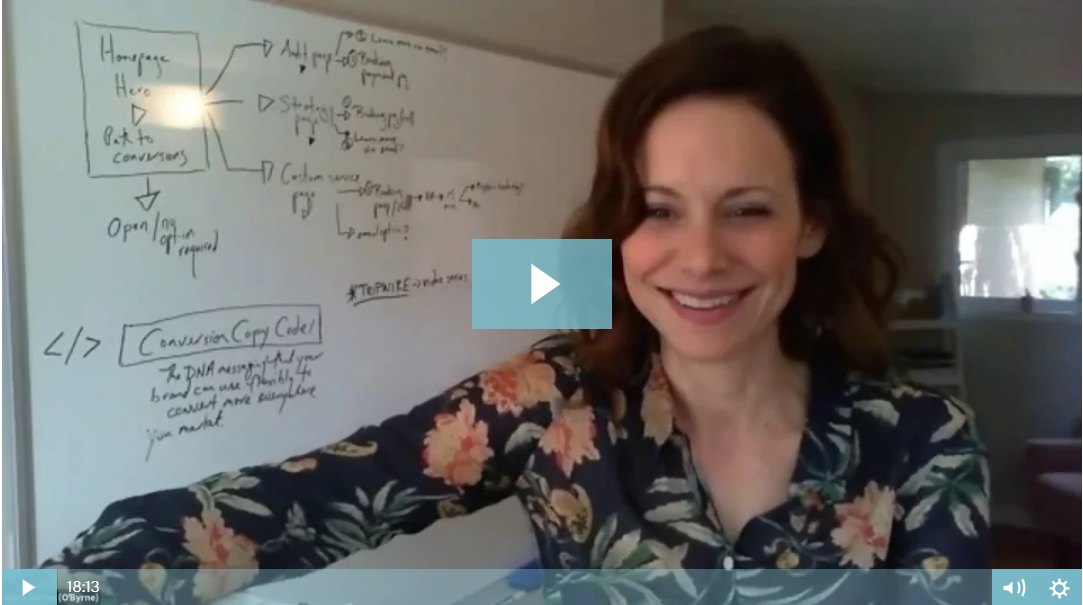
The day I set up my first opt-in form, it was a fire drill.
I had to scramble to set up my first landing page inside ConvertKit because my new site was delayed, but I was going live on a Copyhackers Tutorial Tuesday webinar, and Joanna offered to post a link to my lead magnet.
In the backend, it was WILD… But I got my first 40 subscribers that day!
And more, over time, as people have watched the webinar recording on the Copyhackers site and signed up for the resources.
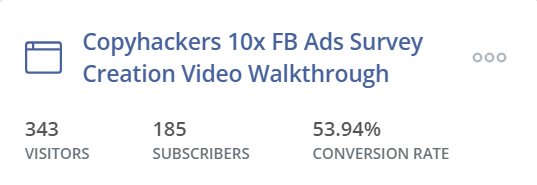
The lead magnet is a how-to video on a topic exclusively of interest to conversion copywriters.
The only problem? I’ve never sold anything to other conversion copywriters.
So, what is that lead magnet even doing for my business?
Not much. It mostly raises brand awareness in my own community, possibly generates referrals…
But since I’d attracted those research-curious conversion copywriters, I felt it was my duty to serve up relevant and useful content.
That took some time and potentially didn’t pay off.
This is a content marketing challenge common to service providers.
We love to write about our process, our techniques, our top tips… Exactly the type of content that attracts others in our professions, but not necessarily leads.
Ultimately, I knew I needed a lead magnet to build my list of prospects: people who hire conversion copywriters.
And what I came up with has served me SOOO well.
Strategic Sales Enablement Lead Magnet
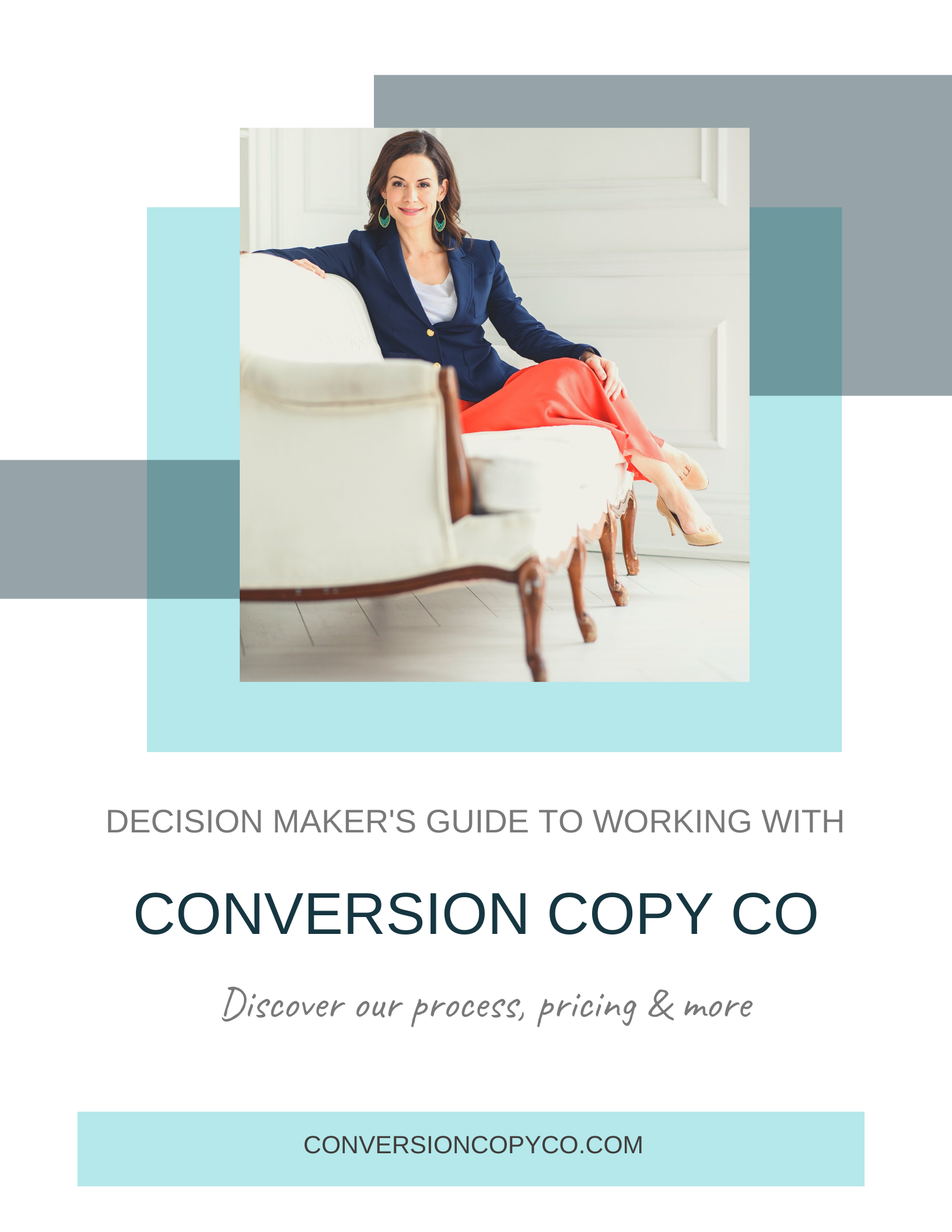
When I created my second lead magnet (still my main lead magnet today) I engineered the topic and content specifically to attract buyers and to grow my list of hot leads.
My main lead magnet, the Decision Maker’s Guide to Working with Conversion Copy Co, converts like crazy and generates a great deal of my business.

First, it works because the topic solves the problem my clients face when they search for a conversion copywriter.
Chances are, they’ve never hired one before. They need more info, but they don’t want to waste too much time on a sales call with the wrong copywriter.
Leads like this may need to get internal buy-in to book a call or hire. Instead of sending their boss or colleagues to explore my site, they can send my PDF guide, which includes the kind of info most copywriters only give out in person.
It’s very targeted: No one downloads this guide because they plan to DIY their conversion copy. It’s explicitly a guide to working with us and has no other functional purpose.
Side benefits:
- The guide completely replaces any need for long proposals (and I tell prospects just that in sales calls).
- It also speeds up sales conversations because prospects who even skim the guide know what we’re about, how we work, what we offer, our results…
- And it weeds out anyone who wouldn’t have closed on a sales call, anyway.
In effect, my high-converting lead magnet doubles as a very effective sales enablement tool.
Other conversion copywriters may download it, too, because they’re curious. But it’s not designed for those copywriters, and I don’t have to serve their interests with the emails that follow.
Oh, and one last thing: I optimized the landing page for search, so I show up right beneath some big names who advertise for the same (very low traffic) terms.
Thought Leadership Lead Magnet
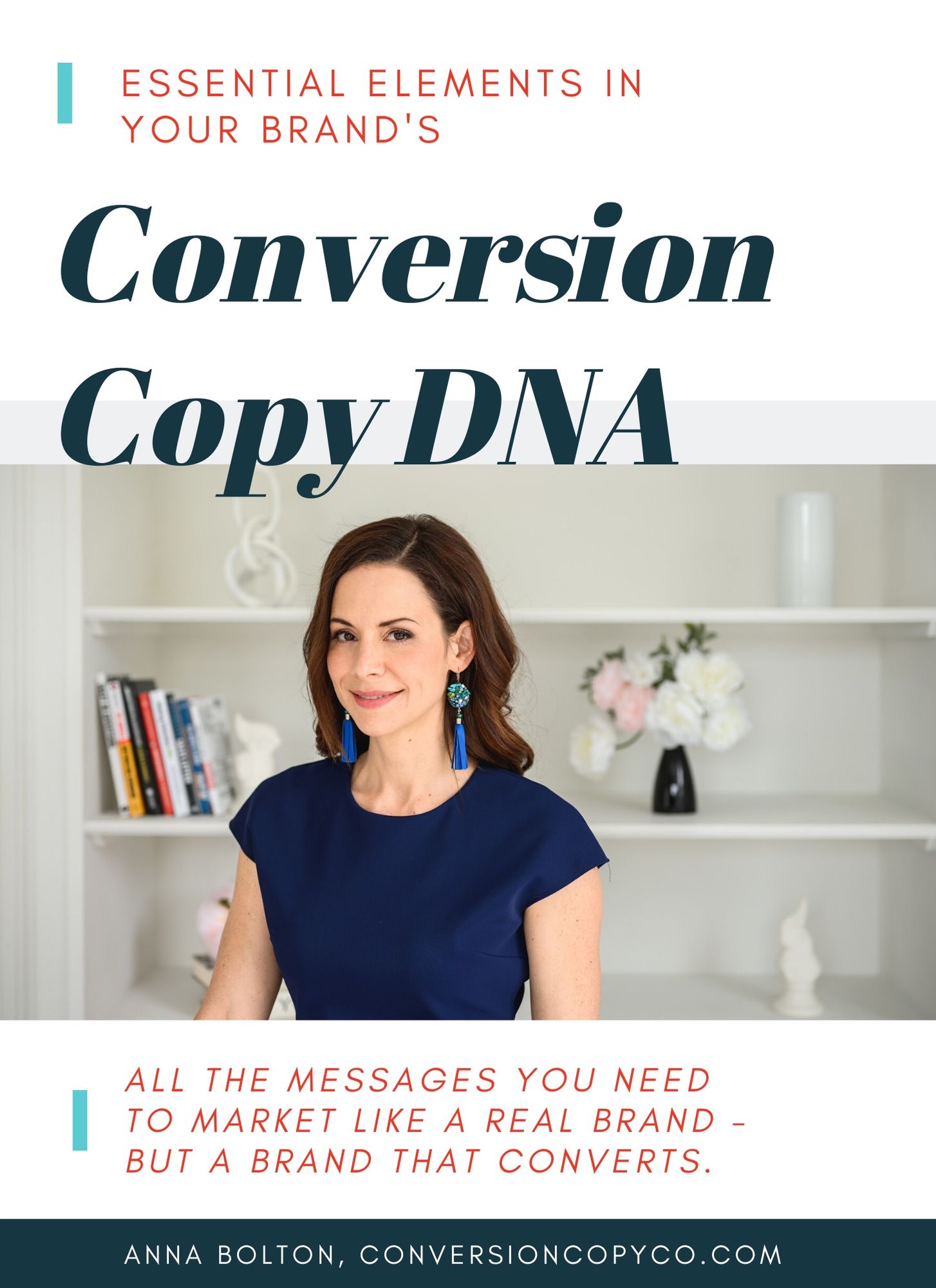
My third lead magnet was more of a thought leadership piece that arose out of an opportunity.
It only exists because I spoke in early 2020 at an online event on my “Copy DNA” process: How to optimize your brand messaging for conversions. And I created a guide to all of the brand messages you’ll need, plus how to write them to convert.
This lead magnet generates some awareness of Conversion Copy Co’s brand messaging services. It also demonstrates that I have perspective and expertise on the topic…
It’s more of a “what” than a “how”, so I’m not undermining my own paid offers. Anyone who wants to DIY using the guide probably isn’t my ideal client.
Anyway…
Two years after publishing, I need to revisit the content, check the analytics, and consider what this particular high-converting lead magnet is doing for my business.
I tend to agree with my (very expert) content strategy friend, Sarah MacKinnon, who argues that thought leadership content is overrated.
Now, let’s look at the conversion rate:
There is definitely something wrong with how ConvertKit is tracking the visitors to this form.

(Look, Jo’, I got a 10000% conversion rate!)
It’s a high-converting lead magnet, but not THAT high.
The total number of subscribers is about right. But how many visitors did we have in total?
Let’s take a peek inside Google Analytics. Looking at unique visitors from all-time (353), I can see that the conversion rate is about 56%.

Not ten thousand percent, but also way above industry standards!
Make Your Lead Magnet Part of Your Conversion & Profit Strategy
Of course, I’m delighted that these lead magnets convert at rates far higher than the industry average. They should. I’m a conversion copywriter.
And I’m the first to admit that conversion rates are essential, but they’re not everything.
Having a high-converting lead magnet only matters if I can leverage my email list to grow and scale the business.
The same is true for you.
Focus first on creating a lead magnet that serves your business strategy, then optimize the opt-in incentive to convert.
You might find that creating a lead magnet raises questions about your business model and your offers. Questions like:
- Do you really know your ideal customer’s needs, wants, and journey to becoming a buyer?
- Do you have an intro offer that’s one step up from the freebie (the lead magnet), so it’s an easy “yes”?
- Can you profit, or at least break even on that intro offer?
- Does the intro offer line up (in the eyes of your buyer) with your most profitable offer?
- If your lead magnet converts like crazy, can you handle the lead flow?
These are all broader growth strategy questions directly tied to the question of your lead magnet.
If you want help coming up with a strategy for a lead magnet that grows your business, book a VIP Day.


























